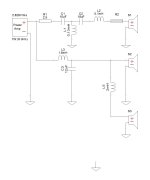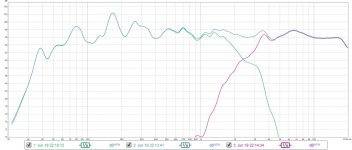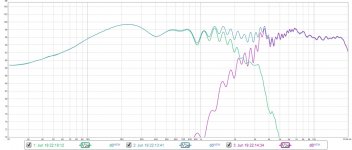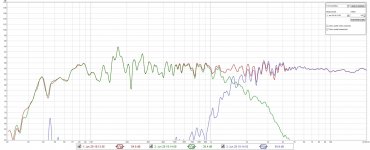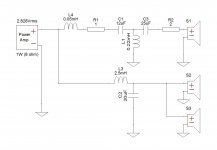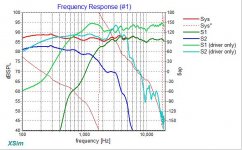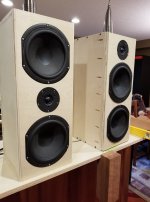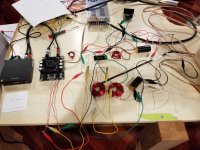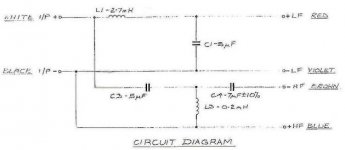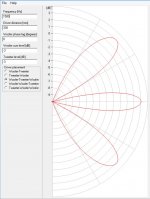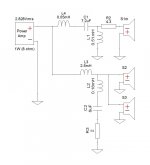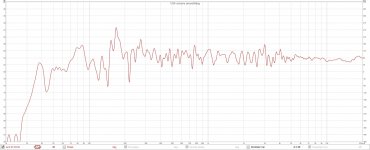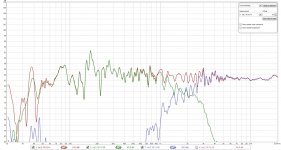Hello,
I have been working on this crossover for a bit.
How does it look?
Any changes you would make or suggestions?
Images,
Crossover
Measurement, no gating, 1/6 smoothing, 2db scale at 30"
Measurement, 5ms gating, 1/24 smoothing, 2db scale at 30"
Thank you,
David.
I have been working on this crossover for a bit.
How does it look?
Any changes you would make or suggestions?
Images,
Crossover
Measurement, no gating, 1/6 smoothing, 2db scale at 30"
Measurement, 5ms gating, 1/24 smoothing, 2db scale at 30"
Thank you,
David.
Attachments
I have never seen a 1" dome tweeter supporting two husky 8" woofers.
The robust 1.1" diameter SB29RDC-4 dome tweeter has been successfully used with one 8" woofer using a steep(BW3 or LR4) 1400Hz crossover.
Since you already have a large cabinet for the two 8" Peerless woofers, adding a sealed volume 5" midrange(4-ohm) with a straight 3-way crossover will not significantly change the cabinet size, but will significantly improve the sound quality.
SB Acoustics SB15NRXC30-4 paper cone, or SB15MFC30-4 plastic cone
Peerless/Tymphany also builds excellent 5" midrange
The robust 1.1" diameter SB29RDC-4 dome tweeter has been successfully used with one 8" woofer using a steep(BW3 or LR4) 1400Hz crossover.
Since you already have a large cabinet for the two 8" Peerless woofers, adding a sealed volume 5" midrange(4-ohm) with a straight 3-way crossover will not significantly change the cabinet size, but will significantly improve the sound quality.
SB Acoustics SB15NRXC30-4 paper cone, or SB15MFC30-4 plastic cone
Peerless/Tymphany also builds excellent 5" midrange
I didn't like the way the 2.5 sounded, so I made another test box of the same speakers in an MTM config and redid the crossover.
The driver reconfiguration and redone crossover made a big difference, I like how this sounds!
The driver reconfiguration and redone crossover made a big difference, I like how this sounds!
Attachments
I was tempted by the 830869 as well. How do you like it? I hadn't read anything that was a rave review and had trouble finding out how it did in the bass department. The Fs looks good tho.
I had read one person who used in a 2 way and wasnt a fan so my plan was to incorporate a small 3-5" mid between woofer and tweet.
How's the bass sound to your ears?
I had read one person who used in a 2 way and wasnt a fan so my plan was to incorporate a small 3-5" mid between woofer and tweet.
How's the bass sound to your ears?
I was tempted by the 830869 as well. How do you like it? I hadn't read anything that was a rave review and had trouble finding out how it did in the bass department. The Fs looks good tho.
I had read one person who used in a 2 way and wasnt a fan so my plan was to incorporate a small 3-5" mid between woofer and tweet.
How's the bass sound to your ears?
The bass is a little off due to the fact I am using a 1.5mH and 1.0mH 18g air core coil with a combine resistance of 1.3 ohm as a 2.5mH coil. That alone pulls down the bass 3-4db in the 100-200 hz range. I ordered 15g laminated 2.5 mH coils with a resistance of 0.164 ohm last night. I like the sound as is, and I am sure I will like it better with the new coils.
I am just a home hobbyist hack who is using the brute force method of crossover design. Model it, try it, try again. I don't know enough to know exactly what I am doing, but I can hear and measure the results. This sounds pretty good. I am eager for the new coils.
I used SB26ADC successfully with the same woofer. Here is my project:
Peerless 830869 + SB26ADC-04 crossover help?
Peerless 830869 + SB26ADC-04 crossover help?
I like 8" bass plus tweeter. My current project is more fun than a carload of monkeys... having a great time fiddling with it. Personally I use a higher 3KHz crossover, because low crossover is just not an option with the tweeters I use.
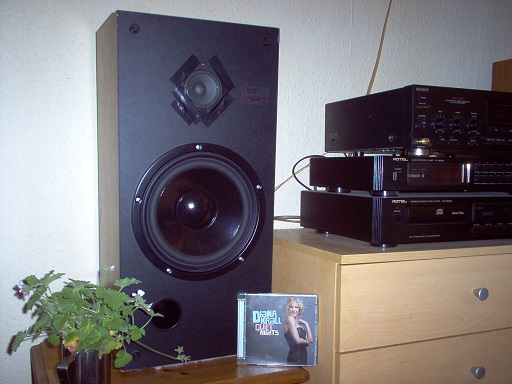
You may find this post and the whole thread helpful for what appears to be a typical medium inductance woofer with a robust DX25 tweeter. This is your standard negative polarity 3Khz crossover used in the KEF Celeste III.
Wharfedale Shelton XP2. A minor classic IMO.
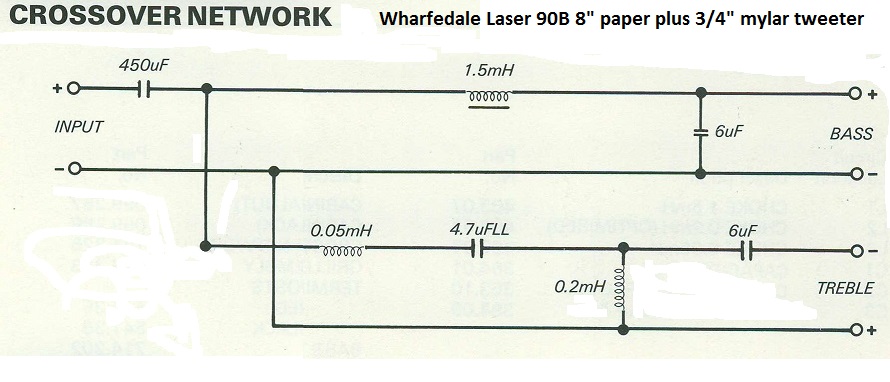
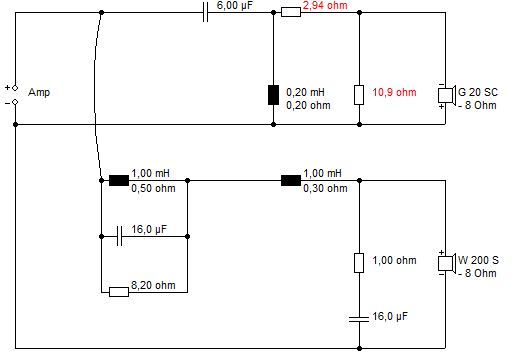
The Shelton XP2 filter is kinda clever IMO. Very steep 12dB/octave rolloff which is just what you might need with that slightly peaky woofer. Conversion to series wired MTM is almost trivial, of course. Parallel wired is trickier. You usually don't have much tweeter level to play with.
You may find this post and the whole thread helpful for what appears to be a typical medium inductance woofer with a robust DX25 tweeter. This is your standard negative polarity 3Khz crossover used in the KEF Celeste III.
Wharfedale Shelton XP2. A minor classic IMO.
The Shelton XP2 filter is kinda clever IMO. Very steep 12dB/octave rolloff which is just what you might need with that slightly peaky woofer. Conversion to series wired MTM is almost trivial, of course. Parallel wired is trickier. You usually don't have much tweeter level to play with.
Attachments
Last edited:
Acoustical Interference pertains to where a common signal in the same frequency range is reproduced by two physically separate sources, such as two drivers operating in the same frequency range, or the frequency overlap of two drivers in the crossover region. If the drivers are separated by a distance greater than ¼ (90 degrees) wavelength of the highest frequency being reproduced, then the time/distance issues that manifest themselves at those frequencies mean that at some angles relative to directly on-axis their outputs combine in phase at the listener, and at some angles their outputs cancel out of phase at the listener.
XDir is a very simple polar pattern modeling simulator which can illustrate acoustic interference (comb filtering) from your MTM topology. 8" mid + 4" tweeter faceplate = 13" = 330mm
Free sine generators can be used to identify acoustical interference effects. Create a stereo 4kHz tweeter-only test tone and adjust gain and phase to sonically put this tone in the center of the stereo sound stage. Now run a slow frequency sweep over about 400 - 4kHz and listen for 3D position shifts and SPL changes of the tone. Stand up and repeat this test.
XDir is a very simple polar pattern modeling simulator which can illustrate acoustic interference (comb filtering) from your MTM topology. 8" mid + 4" tweeter faceplate = 13" = 330mm
Free sine generators can be used to identify acoustical interference effects. Create a stereo 4kHz tweeter-only test tone and adjust gain and phase to sonically put this tone in the center of the stereo sound stage. Now run a slow frequency sweep over about 400 - 4kHz and listen for 3D position shifts and SPL changes of the tone. Stand up and repeat this test.
Attachments
Acoustical Interference pertains to where a common signal in the same frequency range is reproduced by two physically separate sources, such as two drivers operating in the same frequency range, or the frequency overlap of two drivers in the crossover region. If the drivers are separated by a distance greater than ¼ (90 degrees) wavelength of the highest frequency being reproduced, then the time/distance issues that manifest themselves at those frequencies mean that at some angles relative to directly on-axis their outputs combine in phase at the listener, and at some angles their outputs cancel out of phase at the listener.
XDir is a very simple polar pattern modeling simulator which can illustrate acoustic interference (comb filtering) from your MTM topology. 8" mid + 4" tweeter faceplate = 13" = 330mm
Free sine generators can be used to identify acoustical interference effects. Create a stereo 4kHz tweeter-only test tone and adjust gain and phase to sonically put this tone in the center of the stereo sound stage. Now run a slow frequency sweep over about 400 - 4kHz and listen for 3D position shifts and SPL changes of the tone. Stand up and repeat this test.
This simulation is wrong. 13 inch is c-c distance for woofer-woofer. If you choose woofer-tweeter-woofer for 1500Hz simulation, c-c distance around 6 inch, significant difference.
- Status
- This old topic is closed. If you want to reopen this topic, contact a moderator using the "Report Post" button.
- Home
- Loudspeakers
- Multi-Way
- How does this Peerless 830869 and DX25BG60-04 2.5 way crossover look?
